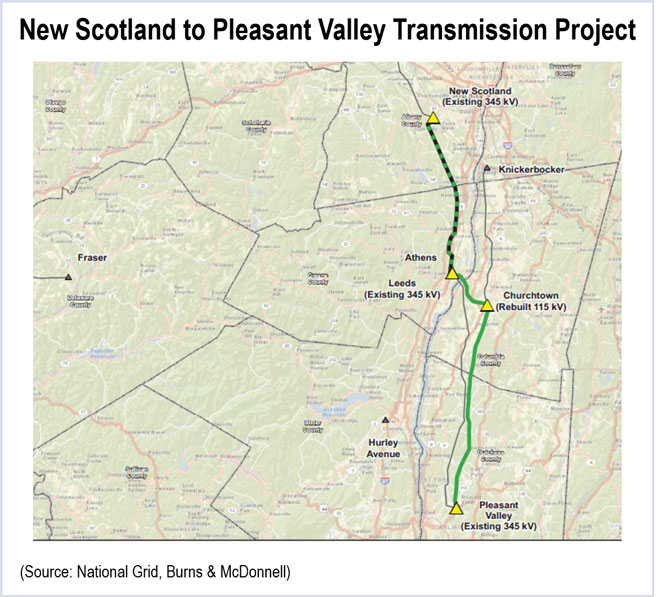By William Opalka
New York utilities have proposed revised transmission upgrades that would add 1,000 MW of capacity to relieve congestion in the Hudson Valley without obtaining new rights of way.
The proposals conform to a recent order by the New York Public Service Commission to use existing rights of way or other utility property to replace aging infrastructure and upgrade older technologies.
The Dec. 14 order (13-M-0457) directed the utilities to revise their previous applications to improve the transmission corridors, with an emphasis on minimizing the visual impact of the lines. The PSC said it was responding to more than 2,000 public comments, many of which opposed the use of new rights of way.
National Grid, Central Hudson Gas & Electric and New York State Electric and Gas filed their revised plans Jan. 7. They, along with an affiliate of Consolidated Edison and Orange and Rockland Utilities, are part of a new organization, New York Transco, which will develop and own the projects once approved by regulators.
The PSC opened the proceeding in November 2012 to press for upgrades to relieve transmission congestion in some areas of upstate New York, particularly interconnections that move power from central New York to within the Hudson Valley. Transmission congestion also prompted the creation of a new capacity zone in areas north of New York City, raising prices for customers in the Lower Hudson Valley.
The utilities filed their original plans in October 2013.
Nine Options
In addition to a modified version of their original proposed project, the utilities’ new filing lists eight alternatives created to address choke points between upstate New York and southeastern New York and other congested transmission lines within the Hudson Valley region. There are four UPNY/SENY Interface alternatives and four UPNY/SENY & Central-East Composite alternatives.
Seven of the nine proposals meet the objective of adding 1,000 MW of capacity to the Hudson Valley region.
The UPNY/SENY alternatives cost less because they address only transfer points at the interface. They range from an estimated $102.5 million to $525 million.
The four composite alternatives are more costly, as they provide system benefits by replacing aging transmission infrastructure. They range in estimated cost from $764 million to nearly $1.19 billion.
The PSC said it will evaluate each of the proposals and determine which ones meet its criteria; not all will be built.
All of the proposed projects would begin construction by 2017 or 2018, with completion of all of the work by the end of 2020.
Concerns over Cost Overruns
On Jan. 15, the transmission owners filed a petition asking the PSC to clarify that current cost estimates are not binding.
In the December order, the PSC said staff recommendations for a risk-sharing approach are “generally consistent with FERC precedent” and that “this approach will ultimately be subject to FERC’s approval.”
The TOs said the PSC’s approach may not conform to FERC policy, putting them and other developers “in a precarious and untenable position.”
“Accordingly, the NYPSC should clarify that it is not mandating that developers adhere to any specific cost estimate or risk sharing mechanism but rather will consider any risk sharing proposal submitted as part of project proposals along with all other factors in determining the best project to meet the public interest.”



